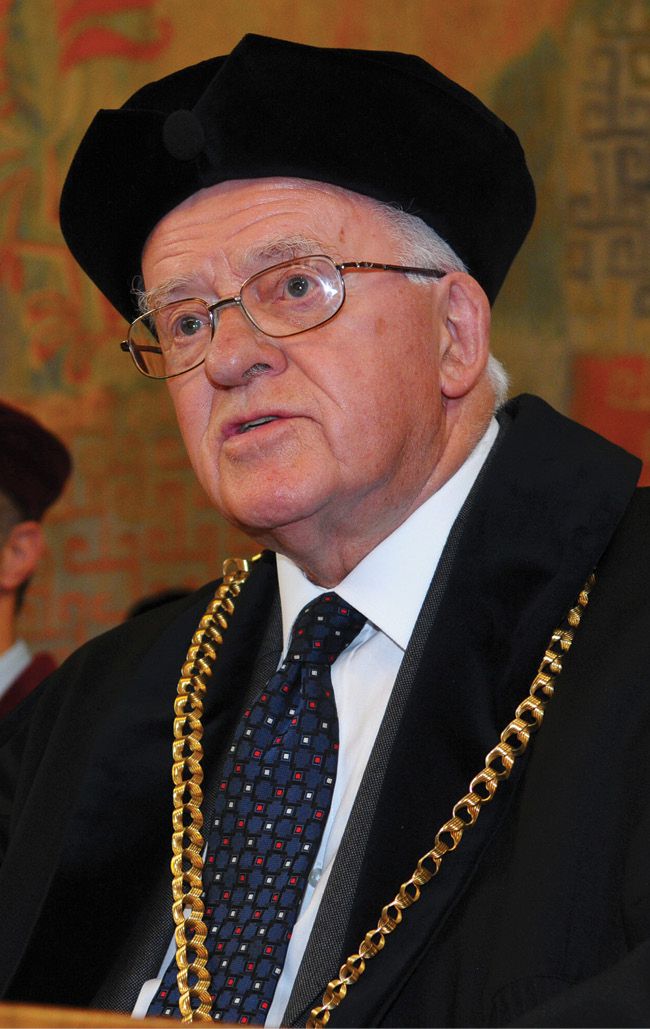William Frank Vinen
DOI: 10.1063/PT.3.5069
William Frank “Joe” Vinen, a pioneer in low-temperature physics, died in Birmingham, UK, on 8 June 2022.He was born on 15 February 1930 in Watford, an English town some 15 miles northwest of London. Vinen earned his undergraduate and graduate degrees from Cambridge University in 1953 and 1956, respectively. Superfluid helium, to which he was introduced by his PhD supervisor, Donald Osborne, became a lifelong passion. When Osborne left Cambridge, Vinen’s new supervisor, David Schoenberg, let him continue his work independently. After receiving his doctorate, Vinen remained at Cambridge until the University of Birmingham offered him a chair in 1962. There he set up a strong low-temperature-physics group, held the prestigious Poynting Chair from 1973, led the School of Physics and Astronomy from 1973 until 1981, and retired in 1997.

William Frank Vinen

In the years following his retirement, Vinen was a frequent and warmly welcomed traveler to the main low-temperature-physics laboratories in Prague, Czech Republic; Osaka, Japan; Manchester, Lancaster, and Newcastle, UK; and Gainesville and Tallahassee, Florida. He motivated scientists at each of those places to investigate aspects of quantum turbulence, such as visualization via excimer helium molecules; generation, dissipation, and decay in the zero-temperature limit and two-fluid states; and Kelvin wave cascades. No retirement was more productive scientifically!
Osborne had shown that rotating helium acquires a parabolic surface, like an ordinary liquid, in apparent disagreement with the two-fluid theory of Lev Landau and Laszlo Tisza. To solve that puzzle, Lars Onsager and then Richard Feynman had proposed that the circulation of the superfluid velocity is quantized in units of h/m, where h is Planck’s constant and m is the mass of one helium atom. That constrains the superfluid vorticity to vortex lines of quantized strength. Henry Hall and Vinen’s second-sound experiments in rotating helium and Vinen’s experiments on helium heat currents in the 1950s provided the first indirect evidence for the quantization. They also revealed a mutual friction between superfluid and normal-fluid components. Vinen demonstrated its importance for helium flows and modeled its effects with great care and physical intuition.
In 1961 Vinen directly measured the quantum of circulation, confirming the Onsager–Feynman conjecture and vindicating Fritz London’s 1938 intuition that the superfluid is governed by a macroscopic wavefunction. The measurement, in which Vinen observed the change of the precessional frequency of a vibrating wire as one or more vortex lines encompassed it, was brilliant in its simplicity. That observation of the quantum character of a macroscopic body predates the related observations of flux quantization in superconductors. The vibrating-wire technique has been applied to many experiments since.
At Birmingham, Vinen led an intense program on type II superconductors with former students Colin Gough and Edward Forgan; they pursued the analogy between magnetic field in superconductors and rotation in superfluids both theoretically (with Philippe Nozières) and experimentally. But Vinen’s interest in helium did not wane—he was attracted by the extraordinary purity achievable in helium compared with other materials.
Vinen performed light-scattering measurements near the lambda transition with Michael Vaughan and worked on the nucleation of a vortex ring by a moving ion. Ions allow studies of the nucleation process free of complications from remanent vortices produced in crossing the lambda transition. Vinen was aware that vortex nucleation requires an energy barrier to be overcome, and, with Chris Muirhead and Russell Donnelly, he calculated the barrier as a function of the geometry of the nascent vortex. Their finding, that the vortex ring starts as a “handle” attached to the spherical ion, was confirmed experimentally at Lancaster University.
That success led Vinen to further nucleation experiments on oscillating ions trapped below the helium surface by electrostatic potentials. The trapped ions form an ideal two-dimensional system, and Vinen showed that they can form a Coulomb crystal. He did more studies of magnetoplasma resonances and ripplons while also working on cuprate superconductors.
It was Vinen’s early experiments that suggested that a superflow breaks into turbulent vortex lines, as proposed by Feynman in 1955. Vinen’s end-of-career work answered the natural question of how that “superfluid” or “quantum” turbulence is related to ordinary (classical) turbulence. In 1993, with Donnelly, he found that turbulence created by towing a grid in helium at rest displays classical scaling behavior over an unprecedented range of length scales. The experiment stimulated work that revealed surprising similarities between quantum and classical turbulence, described in his and Joseph Niemela’s widely cited review in the Journal of Low Temperature Physics.
In the superfluid literature, Vinen’s name is attached to three concepts: the Vinen equation, describing the evolution of the vortex-line density; the Hall-Vinen-Bekharevich-Khalatnikov equation, which generalizes the two-fluid equations by incorporating vortex lines; and Vinen turbulence, which is a state of turbulence that is devoid of the energy cascade found in classical turbulence. In recognition of his work, Vinen was awarded the Simon Memorial Prize (with Hall) in 1963, the Fernand Holweck Medal and Prize in 1978, the Rumford Medal in 1980, and the Guthrie Medal and Prize in 2005. He will be missed by his many friends across several generations.
More about the Authors
Carlo Barenghi. Newcastle University, Newcastle, UK.
Peter McClintock. Lancaster University, Lancaster, UK.
Ladislav Skrbek. Charles University, Prague, Czech Republic.
Katepalli Sreenivasan. New York University, New York City.
